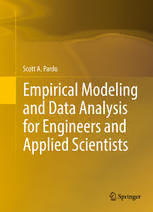Table Of ContentScott A. Pardo
Empirical Modeling
and Data Analysis
for Engineers and
Applied Scientists
Empirical Modeling and Data Analysis for Engineers
and Applied Scientists
Scott A. Pardo
Empirical Modeling and Data
Analysis for Engineers
and Applied Scientists
With contributions by Yehudah A. Pardo
ScottA.Pardo
AscensiaDiabetesCare
Parsippany,NJ,USA
ISBN978-3-319-32767-9 ISBN978-3-319-32768-6 (eBook)
DOI10.1007/978-3-319-32768-6
LibraryofCongressControlNumber:2016941324
#SpringerInternationalPublishingSwitzerland2016
This work is subject to copyright. All rights are reserved by the Publisher, whether the whole or part of the material is
concerned, specifically the rights of translation, reprinting, reuse of illustrations, recitation, broadcasting, reproduction on
microfilmsorinanyotherphysicalway,andtransmissionorinformationstorageandretrieval,electronicadaptation,computer
software,orbysimilarordissimilarmethodologynowknownorhereafterdeveloped.
Theuseofgeneraldescriptivenames,registerednames,trademarks,servicemarks,etc.inthispublicationdoesnotimply,even
in the absence ofa specific statement,that such names are exemptfrom the relevant protective lawsand regulationsand
thereforefreeforgeneraluse.
Thepublisher,theauthorsandtheeditorsaresafetoassumethattheadviceandinformationinthisbookarebelievedtobetrue
andaccurateatthedateofpublication.Neitherthepublishernortheauthorsortheeditorsgiveawarranty,expressorimplied,
withrespecttothematerialcontainedhereinorforanyerrorsoromissionsthatmayhavebeenmade.
Printedonacid-freepaper
ThisSpringerimprintispublishedbySpringerNature
TheregisteredcompanyisSpringerInternationalPublishingAGSwitzerland
Preface
Scienceisaboutdiscovery.Discoveryistheprimaryparadigmofscience.Theprimaryparadigmof
engineeringand“applied science” is design.All scientists, whetherphysicists,biologists,chemists,
psychologists, sociologists, anthropologists, economists, geologists, or any other “ists,” attempt to
discoverthings.Sometimes,theywanttodiscovertheexistenceofsomething;sometimestheywant
todiscoverhow somethingworks; sometimesthey wanttodiscover howseveralthings arerelated;
sometimes they want to discover why something exists. Regardless, scientists are in the discovery
business. They do not in general want to alter the natural world; they want to understand it. In
contrast, the primary paradigm of engineering and applied science is design. Engineers, and those
whowewillcall“appliedscientists,”wanttodesignthings.Clearly,itisimportantfortheengineers
and applied scientists, whom we will call EASs, to understand nature and natural phenomena, but
understanding is not their goal. Their goal is to exploit nature, hopefully in a beneficial and
benevolent manner, in order to make something happen. Thus, the primary goal of the engineer
andappliedscientistisdesign.
Statistics, as a discipline, is mostly oriented toward the discovery paradigm. Statistics courses
emphasizecreatingpredictivemodelsorclassificatorymodels,eitherpredictingnatureorclassifying
individuals.Mostcommonly,wehopetorejectthehypothesisofnoeffect,infavorofdiscoveringan
effect.Itseemsthatoftenstatisticsisusedtoproveordisprovetheexistenceofsomephenomenon,as
opposed to aiding in the design of a product or process. This is not to say that statistical methods
cannotbeused,orareneverused,tohelpdesignsomething.Chemicalengineersmayusedesigned
experimentstooptimizeaprocess;manufacturingengineersmayuseexperimentaldatatooptimize
theoperationofamachine;industrialengineersmightusedatatodeterminetheoptimalnumberof
operatorsrequiredinamanualassemblyprocess.Thistextisaboutgatheringandanalyzingempirical
observations(data)inordertoaidinmakingdesigndecisions.TheEASmaybelievethatexperimen-
tation is unnecessary for designing. He or she might believe that design decisions should be made
withoutanyempiricalobservationandthatexperimentationisonlyusefulforverifyingorvalidating
designs. Every electrical engineer knows that V ¼ IR, but what happens to V if both I and R have
some random components? What about the ideal gas law, P¼kT? There seems to be no need for
V
empirical data when applying these laws. The formulas and equations learned in an elementary
physicscoursemaytakeonnewmeaningwhenaccountingforprobabilisticvariation.Also,thereare
manydesignsituationswherenosimpleequationexists.ThistextismeanttospeaktotheEAS,and
hopefullymotivateherorhimtoexperiment,withthedesignobjectiveinmind.
Much of the discussion in this book is about models. Models are by definition incorrect. The
question is not whether the model truly represents reality, but rather whether the model adequately
v
vi Preface
representsrealitywithrespecttotheproblemathand.Manyoftheideaspresentedwillfocusonhow
togatherdatainthemostefficientwaypossibleinordertoconstructanadequatemodel.
Thestatisticalmethodspresentedarenotnew.Ingeneral,thetechniquesandconceptsintroduced
inthisbookaremeanttostimulatethereader’simaginationandnotmeanttobethedefinitiveanswers
toproblems.Certainly,theideaspresentedarenotanexhaustivelist.Theauthorshopethatthisbook
willpresentavarietyofdesignsituationsfamiliartomanyengineersandappliedscientistsandinspire
thereadertoincorporateexperimentationandempiricalinvestigationintothedesignprocess.
Softwareisintegrallylinkedtostatisticalanalyses.Examplesinthisbookhavebeenworkedusing
several packages/languages/programs, notably SAS, R, JMP, Minitab, and MS Excel. It is the
authors’ belief that there is no “best” software in general. All packages and languages have
advantages and disadvantages. The point of using several types of software was simply to demon-
stratethatnoonepackageorlanguageisbestoverall.Thistextisnotaprimeronsoftware,however.
Itisassumedthatthereaderhasfamiliaritywithsomedataanalysissoftware.
Thismaterialcanbeusedattheadvancedundergraduateorfirst-yeargraduatelevel.Thestudents
whowouldmostbenefitfromthisbookarethosestudyingengineeringorappliedscience.Thestudent
would benefit greatly from some accompanying laboratory work. While fully worked examples are
givenineverychapter,thereisnoteacherlikehands-onexperience.Mostofthechaptersinthisbook
aresubjectsthatarecoveredinanentirebookbyitself.Thegoalistointroducethestudenttoideas
aboutempiricalinvestigationinsuchawayastomotivatehimorhertouseexperimentationasanaid
todesign.
The authors encourage instructors to assign the students practical experience in conducting
experiments, making measurements and observations, and analyzing their data. Ideally, the student
shouldusedatathatareintrinsicallymeaningfultohimorher,suchasexperimentaldataassociated
with a thesis or dissertation. The fundamental learning objective of this book is for the reader to
understandhowexperimentaldatacanbeusedtomakedesigndecisionsandtobefamiliarwiththe
mostcommontypesofexperimentaldesignsandanalysismethods.
Althoughthetextincludesintroductorychaptersinprobabilityandstatistics,itwouldgreatlyhelp
thestudenttohavealreadybeenexposedtothosesubjects,aswellassomelinearalgebra.
We mustmakeasmallapologyabout the letter “p.”We use thislettertosymbolize probability,
numbersofparametersinamodel,andpowersof½.Itcanbealittleconfusing.Atleastthereaderis
warned.
Abriefwordaboutdata-intensivemodelingmethods,suchasartificialneuralnetworksandfuzzy
algorithms,is appropriate.This is brief, because thosemethods are notmentioned atallinthe text.
Whilevaluableandimportant,theycouldhaveandhavehadentiretextsdevotedtothosetechniques.
This text will focus on methods that can be used with “small” data sets, generally gathered in a
designedexperiment.
How to Use This Book as a Text
Thisbookcouldbeusedasatextforacoursetitledsomethingalongthelinesof“StatisticalMethods
forEngineersandAppliedScientists,”“ExperimentationintheDesignProcess,”or“UsingEmpirical
Data to Aid in the Design of Products and Processes.” It could also provide students some more
in-depthdiscussionofstatisticalmethodsdiscussedinaDesignforSixSigmacourse.Thefirstseven
chapters are largely about factorial experimentation, although the material in Chap. 3 on measure-
ment systems does not traditionally appear in experimental design texts. The remaining chapters
might be called “special topics in data analysis,” and much of that material involves application of
experimentaldesigns.Thebookisintendedtostimulatestudentstoengageinempiricalinvestigation
Preface vii
as part of their design process. It is not a text about engineering design, nor is it strictly an
experimental design text. There are many topics in experimental design and analysis that are not
included (e.g., split-plot designs, One-way ANOVA, partially balanced incomplete blocks, and the
methodofsteepestascent),andvirtuallynodiscussionaboutengineeringdesign,perse.Rather,itis
intendedtohelpthestudentunderstandhowempiricalinvestigationandempiricalmodelscouldbe
used to aid in design. If students had previously taken a course in the elements of probability and
statistical theory, the first two chapters could be skipped. Otherwise, the authors suggest covering
Chaps.1and2inthefirstweekandonechaptereachweekthereafter.Someofthechapters,notably
Chaps.11(Reliability)and15(RobustDesign),mightrequiremoretimethan1week.Ofcourse,the
instructor should use her or his discretion in including additional materials, excluding some of the
text,orthetimingofcoverageforanyofthetext’smaterial.
Parsippany,NJ,USA ScottA.Pardo
Acknowledgments
S.P.wouldliketoacknowledgethecontributionsofhiswifeandpartner,andY.P.hismother,tothe
completion of this book. She provided insights and suggestions that greatly enhanced the structure
andcontentofthetext,makingitmorecompleteandusefulthanitwouldhavebeenwithoutherhelp.
TheyalsoacknowledgethecontributionsofMichaelA.PardoandJeremyD.Pardo,sons,brothers,
and collaborators, whose descriptions of their own scientific endeavors, and questions about our
intentions and thoughts, redirected our thinking and helped us broaden our vision of the “applied
scientist.” Finally, we would like to thank Dr. Rezi Zawadzki for her reviews of the manuscript,
comments,andencouragement.
ix

